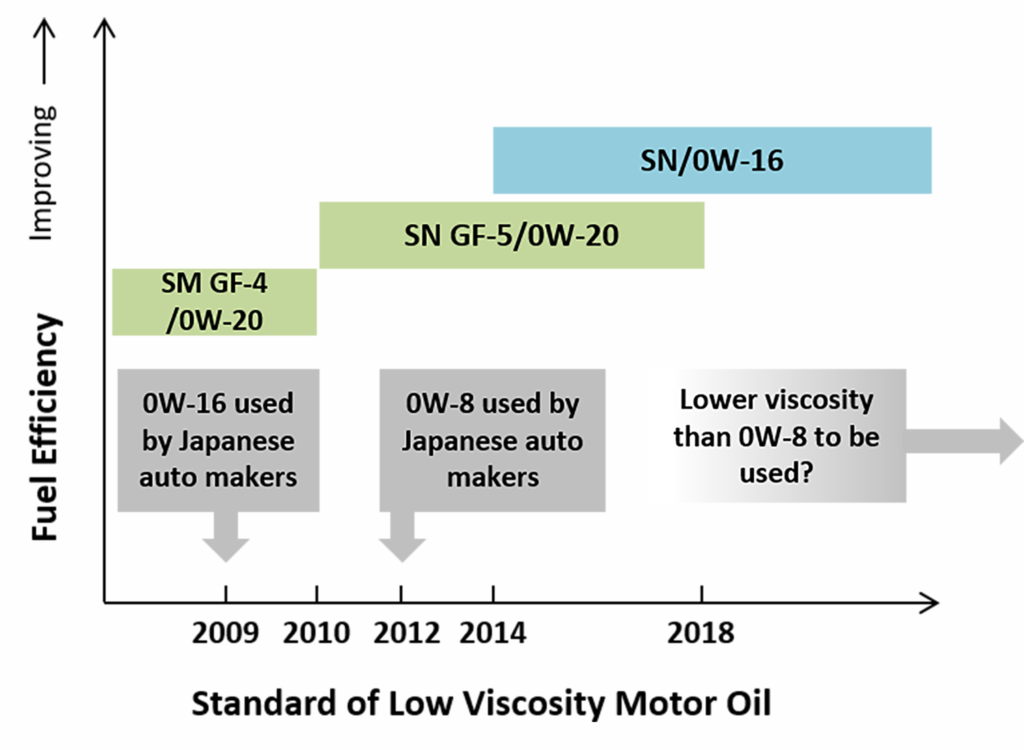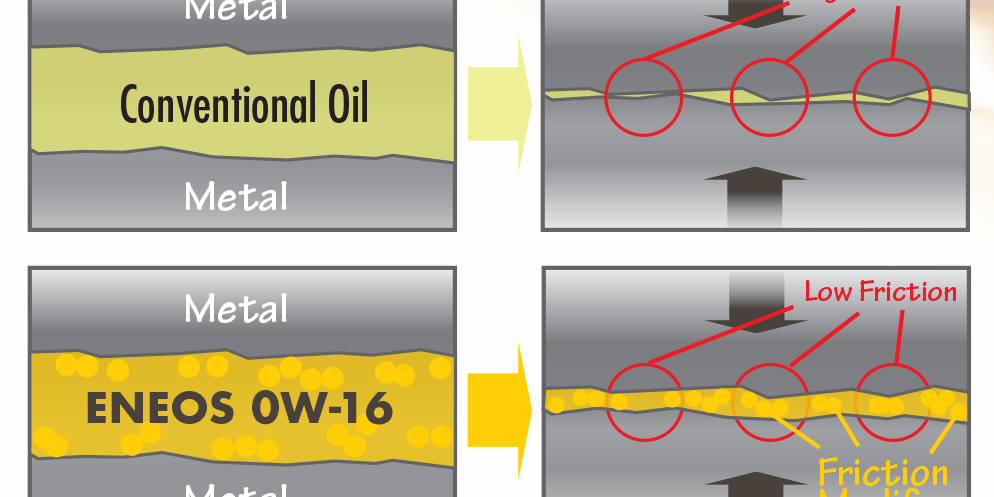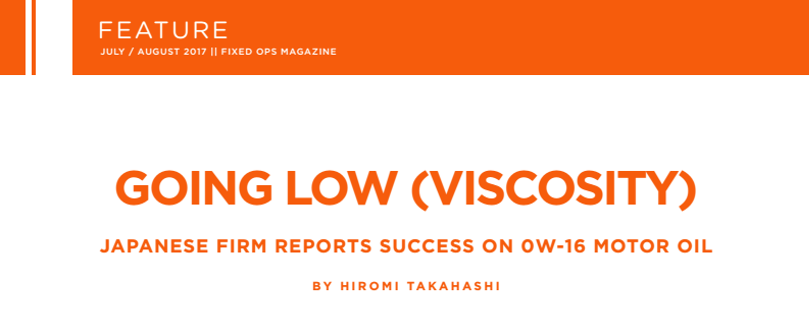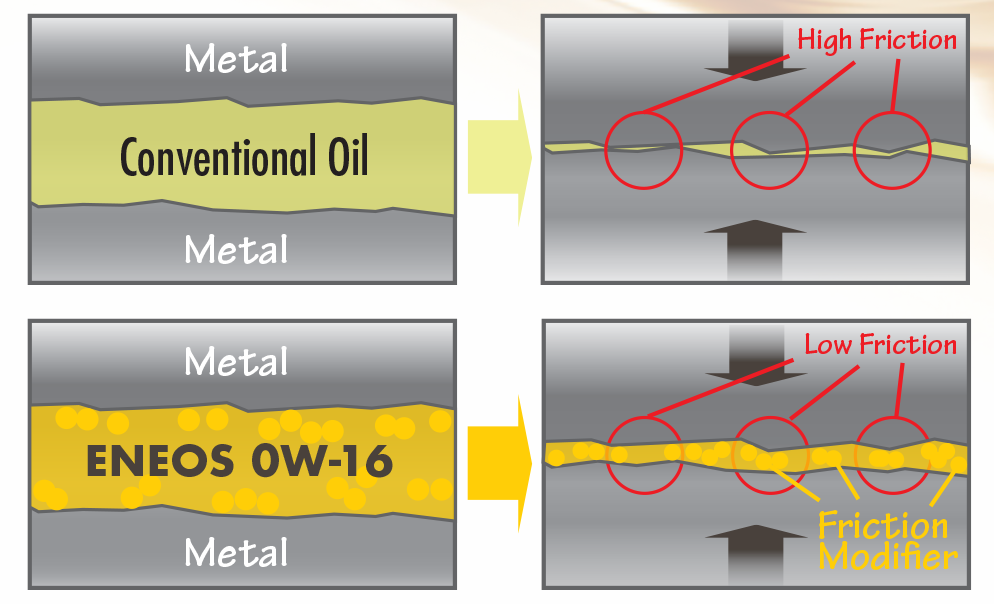In the July/August issue, Fixed Ops, an industry trade magazine dedicated to fixed operations of auto dealership business (service, parts, etc.), printed an article written by our Deputy General Manager, Hiromi Takahashi, about the emerging lower viscosity motor oils, with a focus on 0W-16 and our role bringing it to market. Here is the article they published.
Because of growing environmental concern that has resulted in new fuel economy regulations worldwide, the motor oil industry has been looking toward lower viscosity of motor oils to help reach improved performance goals.
The move toward low viscosity motor oil was initiated in Japan, continuing a longtime trend by Japanese automakers to build extremely fuel-efficient vehicles, something they have extended with the increasing success of hybrid models and eco cars.
Japanese automakers have used 0W-16 for factory fill in Japan since 2009 and are now also using lower viscosity oils than 0W-16 to increase fuel efficiency.
JXTG Nippon Oil & Energy, the parent company of ENEOS, has been working with Japanese automakers to develop such ultra-low-viscosity oils since the late 1990s.
Now, some North American-based Japanese automakers have begun to move to 0W-16, the lowest viscosity grade of the API standard for PCMO (passenger car motor oil), for factory fill of their new vehicles, which have tighter tolerances and are designed to work best with ultra-low-viscosity oils.
ENEOS is now producing 0W-16 in the U.S. to provide the first OE factory fill for North American-produced vehicles. Following this accelerating increase in factory fill use, 0W-16 will be gradually adopted in the consumer market through dealerships and individuals on the cutting edge of technology, who will likely deploy 0W-16 before it’s picked up more widely, at first by dealerships and eventually by lube and service center chains.
Economic and Environmental Impact
A primary benefit of 0W-16 has been increased fuel economy.
Hiroya Miyamoto, a Senior Manager at JX Nippon Oil & Energy USA, Inc., reports that 0W-16 showed an improvement in fuel efficiency by two percent compared to a 0W-20 when tested in the popular Honda Fit using their chassis dynamometers.
“0W-16 can contribute to saving money for its users and in the reduction of C02 emissions,” Miyamoto says. “Drivers can actively contribute to protecting the environment by using 0W-16.”
Pros and Cons
With its availability and use increasing, understanding the benefits and drawbacks of 0W-16 is important.
As mentioned, in the past, there have been concerns with lower viscosity oils increasing engine wear, as well as reducing oil pressure and increasing oil consumption. However, 0W-16 has been tested with many types of engines (provided through research and development relationships with original equipment manufacturers) to ensure its performance met the requirements of Japanese automakers.
“In order to solve the trade-off of protection for performance, it was necessary to precisely design optimal viscosity at a wide range temperature and carefully select additives,” Miyamoto says.
Friction modifiers developed for 0W-16 increase oil film retention capacity, which helps to protect the engine and combat other performance issues.
In addition, the special formulation for 0W-16 gives it better flow at cold temperatures because of the optimal balancing of synthetic base oils and proprietary polymer additives, which also provides faster engine turnover and response at cold temperatures.
Current Use Applications
0W-16 created for Japanese OEM applications has been in use in Japan for over a decade, during which time it has been refined for use in many Japanese vehicle applications from leading Japanese automakers in both conventional internal combustion engines as well as hybrid vehicles.
0W-16 is currently being recommended for the following cars:
Toyota
- Camry 4-cylinder gasoline engines (2018 model year)
- Camry Hybrid (2018 model year)
- Prius C*
Honda
- Fit (from 2013 model year)*
- Hybrid Cars (Accord, Odyssey, CR-Z, Fit)*
*Vehicles manufactured in Japan | (New vehicle applications are introduced periodically.)
R&D Legacy
 0W-16 has a specific footprint for extremely economical vehicles, but as a company that globally provides custom lubricants products both to Japanese automakers for factory fill and Service fill, the JXTG perspective on ultra-low-viscosity oil developments is a bit different.
0W-16 has a specific footprint for extremely economical vehicles, but as a company that globally provides custom lubricants products both to Japanese automakers for factory fill and Service fill, the JXTG perspective on ultra-low-viscosity oil developments is a bit different.
Our company has been working with early adapters over the past two decades to get the product to market. In the U.S., it also works with early adopters with its consumer products, which are currently used primarily by smaller specialty Service facilities and tuners that embrace performance aftermarket offerings. Both segments are anticipated to embrace 0W-16 in different ways.
The goal is to help reach improved environmental and fuel efficiency goals through its products.
“Our commitment can be seen in our purchase of precisely set engine test stands and chassis dynamometers, which allow vehicles to simulate prescribed driving conditions in a laboratory,” Miyamoto says. “Only a few lubricant manufacturers in the world have this equipment.”
Using advanced in-house research and technology, which has been developed in conjunction with automakers to create lubricants customized for the tighter tolerances of vehicles, The industry has continued to seek lower viscosity oils without the potential risks for increasing engine wear and higher levels of oil consumption. A Japanese automaker has already used 0W-8 for their factory fills in Japan since 2012 and may move on studying “super low viscosity oil,” which may be lower than 0W-8. (The new ILSAC specification for passenger car motor oils, GF-6, is expected to have a first license date of April 1, 2018 although this license date has been delayed several times during the development process and some experts expect it to slip into 2019.)
Miyamoto hopes to continue to support ILSAC by providing supporting data in relation to ultra-low-viscosity oils, which will be leveraged to develop the GF-6 standard. According to an additive company (which is involved in development of the GF-6 standard) the trend to lower viscosities will continue with the introduction of a new ILSAC standard following GF-6.
 It’s starting to be used in OEM factory fills in the U.S. and is being made available to the public in retail and service locations. And, even though the individual efficiencies are small, on a widerscale, its use will help the environment and provide further fuel use reductions.
It’s starting to be used in OEM factory fills in the U.S. and is being made available to the public in retail and service locations. And, even though the individual efficiencies are small, on a widerscale, its use will help the environment and provide further fuel use reductions.
In short, 0W-16 is here to stay.
View original article | Online verison
View ENEOS 0W-16 product page



